Is Brown Rice Healthy, and Should You Choose It Over White Rice? Here’s What a Nutritionist Says–
These are the top nutritional benefits of brown rice to keep in mind.

The following written content via Cynthia Sass, MPH, RD
As a nutritionist, many of my clients tell me they’ve heard they should choose brown rice over white rice. Indeed, brown rice is a nutrient-rich source of energizing carbs that’s widely considered the more healthful option. But why is that the case? Here’s what you should know about brown rice, including its nutritional value; health benefits; and ways to incorporate it into meals, snacks, and even desserts.

Brown rice vs white rice
Brown rice is a whole grain. A grain is considered to be ‘whole’ if its three original parts—the bran, germ, and endosperm—stay intact. A grain’s bran is its fibrous outer skin. The germ is its embryo, which has the potential to sprout into a new plant. The endosperm is the germ’s starchy food supply.
Since brown rice keeps all of the original parts, it provides more than twice as much fiber compared to its white counterpart. That’s because white rice is not a whole grain; it’s refined, meaning the bran and germ are stripped away, leaving only the endosperm. As a whole grain, brown rice also packs higher levels of essential nutrients.
Brown rice nutrition
One cup of cooked long-grain brown rice contains 248 calories, 5.5 grams of protein, 52 grams of carbohydrate with 3 grams as fiber, and less than 2 grams of fat, according to the US Department of Agriculture database. Brown rice is also naturally rich in vitamins and minerals. That same portion, about the size of a tennis ball, packs 88% of the daily need for manganese, a mineral needed for immune function, collagen production, and strong bones, and over 20% of the daily need for magnesium, required for muscle and nerve function, DNA production, and regulation of blood sugar and blood pressure. Cooked brown rice also supplies between 10% and 27% of the daily goal for selenium, copper, phosphorus, and several B vitamins, other essential nutrients needed for optimal health.
This hearty whole grain is also bursting with health-protective antioxidants. A 2018 study published in the journal Antioxidants concluded that brown rice contains many types of phenolic compounds. This common antioxidant group is known to protect cells against damage linked to a greater risk of type 2 diabetes, obesity, cancer, and heart disease.
Blood sugar regulation
Subscribe here
Eating brown rice has been shown to result in better post-meal blood sugar control in people with diabetes and may even help prevent type 2 diabetes. Several studies have also found that replacing white rice with brown rice can reduce the risk of type 2 diabetes. The effects are attributed to the grain’s fiber, slow-burning starch, nutrients, and antioxidants, as well as its ability to help feed beneficial bacteria in the gut, such as Lactobacillus and Bifidobacterium, which are tied to diabetes and obesity prevention. Read more from Health.





